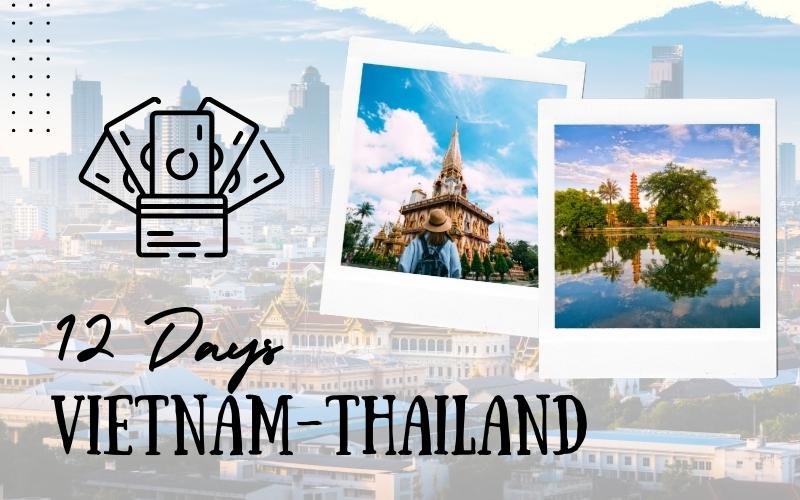
Vietnam and Thailand are the two most beautiful countries in Southeast Asia. They are perfect destinations for travelers of all kinds, from cultural lovers to adventurers. From the limestone karsts of Halong Bay and the bustling Mekong Delta in Vietnam to Thailand’s pristine beaches and northern mountains, the range of landscapes is astounding. To discover them all, you may need up to 3 – 4 weeks. However, if time does not permit, 12 days in Vietnam and Thailand is enough for you to explore the major highlights of both countries. Wondering how, let’s check in the following article.
Best Time for 12 Days in Vietnam and Thailand
The best time for your trip to Vietnam and Thailand is from November to April, when the climate is agreeable for sightseeing, with temperatures averaging between 21 to 28°C. It’s important to note that this period aligns with the primary tourist season in both nations. As such, early reservations for hotels and air travel are recommended to avoid disappointments.
If you prefer a quieter experience and possibly better deals, consider traveling from May to October. The weather remains welcoming, though you might encounter a bit more rainfall. During these months, temperatures in both countries hover between 25 to 35°C. It is scorching during the day but evenings can become cool, so packing a light jacket or sweater is a smart choice to remain comfortable during nighttime in both Vietnam and Thailand.
>>> Read more: The Best Time to Visit Vietnam.
Best Places to Visit on Your Thailand and Vietnam Trip
Bangkok
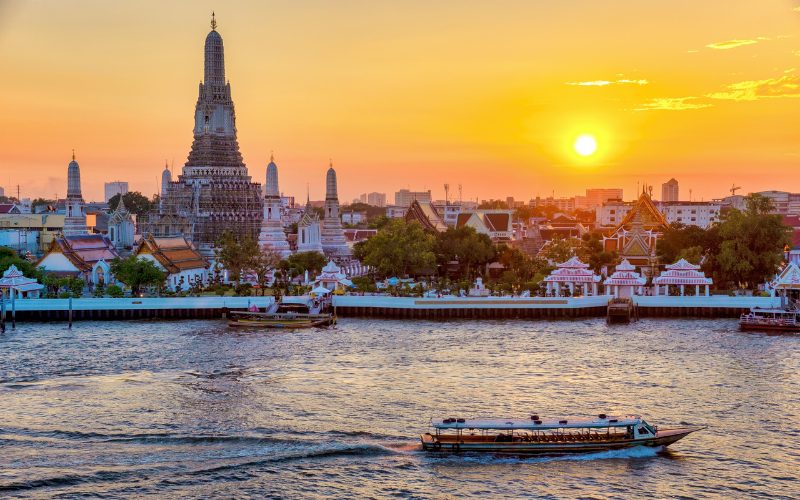
Bangkok City
Visit Vietnam and Thailand in 12 days, you can’t miss Bangkok – the dynamic capital of Thailand and also a mesmerizing blend of the old and new. Its skyline is a mix of glittering skyscrapers and golden temples. At its heart lies the magnificent Grand Palace, a sprawling complex that was once the residence of the Kings of Siam. Nearby is Wat Phra Kaew, home to the revered Emerald Buddha.
The city’s canals and bustling markets of Bangkok, like Chatuchak, offer an authentic Thai experience. As night falls, the streets come alive with street food vendors offering delicious local fare. You can explore the high-octane nightlife of Khao San Road or the serene ambiance of Wat Arun by the river.
Chiang Mai
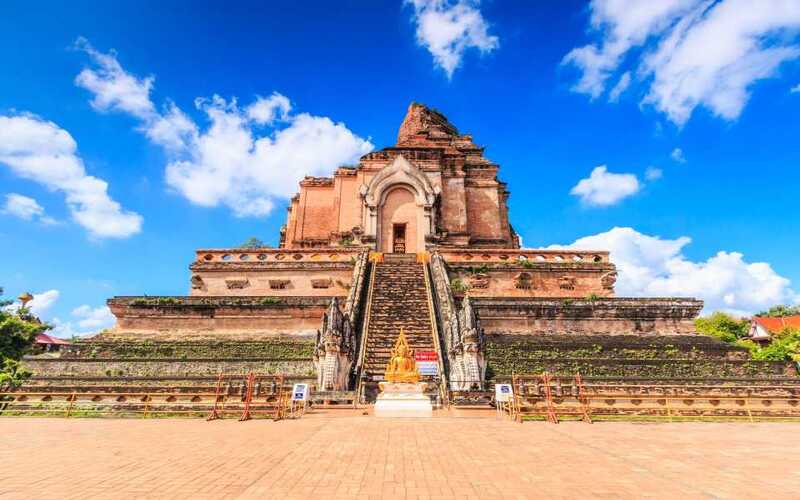
Wat Chedi Luang in Chiang Mai
Chiang Mai is considered the Rose of Northern Thailand, boasting over 300 temples, with Wat Phra Singh and Wat Chedi Luang being standout masterpieces of Lanna architecture. Its ancient city walls tell tales of its storied past. Just outside the city, you can find lush countryside, traditional hill tribes, and sanctuaries like the Elephant Nature Park, where elephants are cared for responsibly. Here, you can also pay a visit to the Night Bazaar, which offers handicrafts and flavors of Northern Thai cuisine.
Phuket
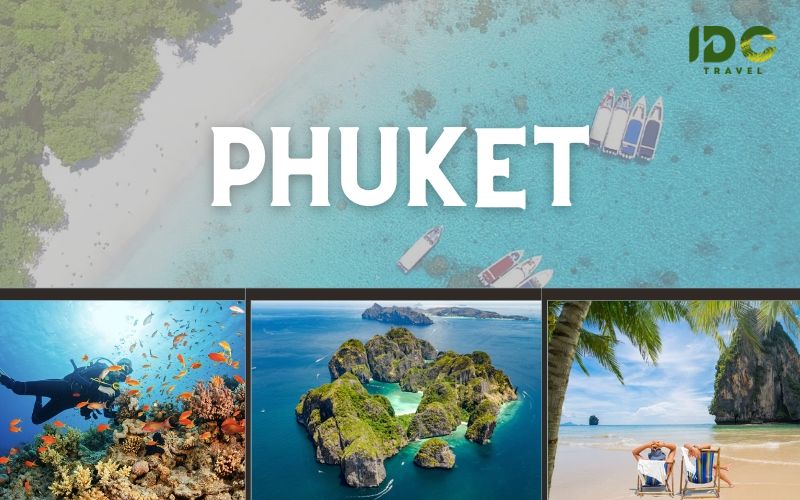
Phuket
Phuket is Thailand’s largest island. It is famous for its golden beaches, notably Patong, Kata, and Karon, offering a blend of relaxation and water sports. The historic Phuket Old Town, with its Sino-Portuguese architecture and vibrant street art, showcases Phuket’s rich cultural tapestry. Seafood lovers can indulge in fresh catches at beachside restaurants. Island-hopping is a must; nearby destinations like the Phi Phi Islands and James Bond Island are renowned for their azure waters and striking limestone formations. As the sun sets, Patong Beach becomes a party hub, with lively bars and clubs.
Hanoi

Hoan Kiem Lake in Hanoi
The capital of Vietnam – Hanoi beautifully marries French colonialism, evident in its boulevards and architecture, with ancient pagodas and temples. Hoan Kiem Lake is its serene core, around which the bustling Old Quarter thrives, offering a maze of streets filled with vendors, traditional crafts, and cafes. Not to be missed is the Ho Chi Minh Mausoleum, a monument dedicated to the founder of modern Vietnam. The nearby Temple of Literature, built in 1070, is a testament to the city’s rich educational heritage. Street food is an essential Hanoi experience, with offerings like ‘Pho’ and ‘Bun Cha’ capturing the essence of Vietnamese cuisine.
Ha Long Bay
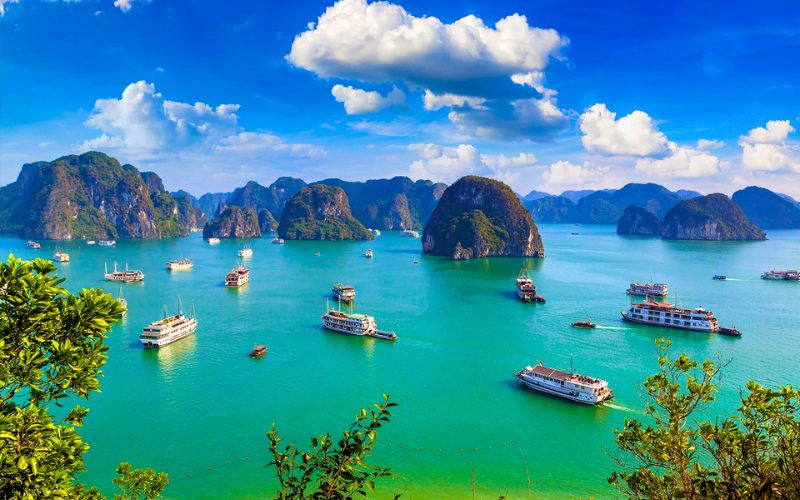
Ha Long Bay
Ha Long Bay, a UNESCO World Heritage site, is a dreamy seascape of limestone karsts rising dramatically from emerald waters. This natural wonder spread over 1,500 square kilometers, features over 1,600 islands and islets, many uninhabited and untouched. Cruising aboard traditional wooden junks offers unparalleled views of these formations, alongside caves like Sung Sot and Dau Go, which hide stunning stalactite and stalagmite formations. Floating fishing villages, such as Vung Vieng and Cua Van, give a glimpse into the lives of those who call the bay home. For the adventurous, activities like kayaking and hiking on Cat Ba Island provide unique vantage points to appreciate the bay’s magnificence.
Hoi An
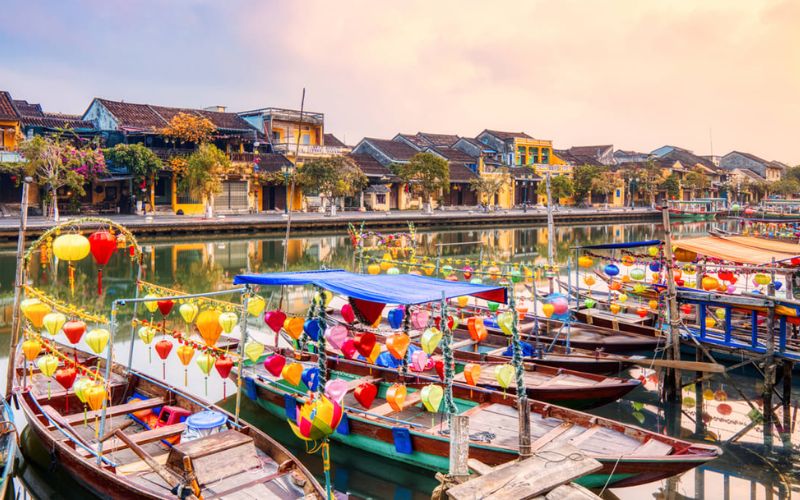
Hoi An Ancient Town
Hoi An Ancient Town, once a bustling port, is a harmonious blend of Vietnamese, Chinese, Japanese, and European influences. Its well-preserved architecture, from wooden Chinese shophouses and temples to colorful French colonial buildings, reflects its multicultural past. The town comes alive at night, illuminated by lanterns, creating an ethereal atmosphere.
Hoi An is also known for its skilled tailors, who craft custom garments in record time. Its proximity to the serene Cua Dai and An Bang beaches, and the verdant rice paddies surrounding it, offer varied experiences. The local cuisine, particularly dishes like “Cao Lau” and “White Rose Dumplings”, is a gastronomic delight.
Ho Chi Minh City
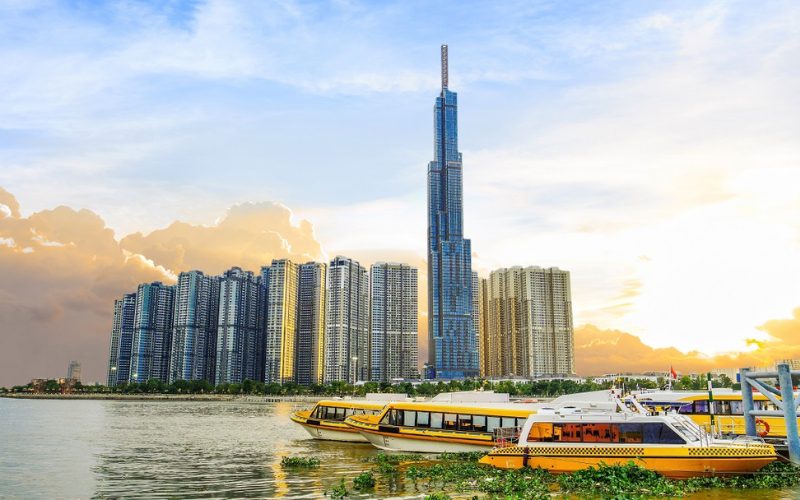
Landmark 81 in Ho Chi Minh City
Formerly known as Saigon, Ho Chi Minh City is Vietnam’s most bustling commercial hub, where skyscrapers stand next to historic pagodas. The city carries the scars and triumphs of Vietnam’s recent history, evident at the War Remnants Museum and Reunification Palace. The Notre Dame Cathedral and Saigon Central Post Office showcase its French influences.
Mekong Delta
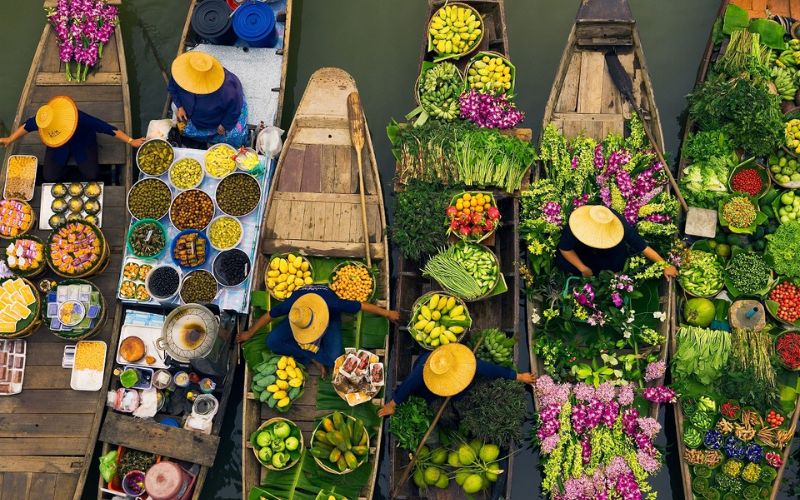
A floating market in the Mekong Delta
The Mekong Delta, often referred to as the ‘Rice Bowl’ of Vietnam, is a mesmerizing water world where boats, houses, and markets float upon a vast network of rivers, swamps, and islands. Spanning over 40,500 square kilometers, it’s a labyrinthine maze where the Mekong River empties into the South China Sea.
The region’s lifeblood is its waterways, brimming with daily floating markets like Cai Rang and Phong Dien, where merchants peddle their goods directly from boats filled with colorful produce. Traditional wooden homes stand on stilts, and fishermen cast their nets, preserving age-old customs. The verdant landscape is dotted with rice paddies, orchards, and sugar-cane groves, reflecting the delta’s agrarian roots.
Suggested Itineraries for 12 Days in Vietnam and Thailand
Itinerary 1: From Bangkok, Thailand
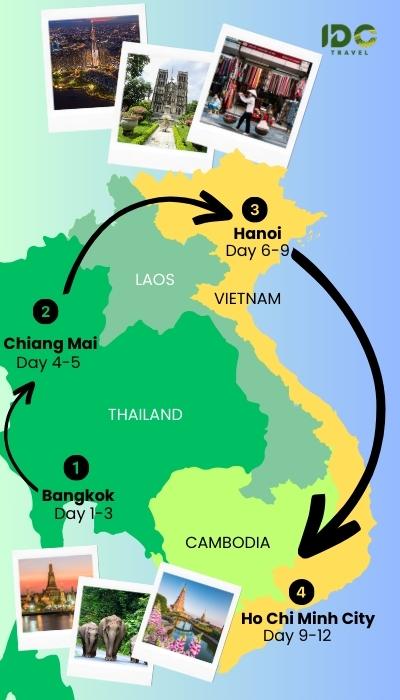
Day 1: Arrive in Bangkok and have time to relax or explore the city on your way.
Day 2: Bangkok city tour over Wat Traimit, Wat Arun, Wat Pho, and finally the Grand Palace.
Day 3: Day tour to Kanchanaburi, visit Damnoen Saduak Floating Market in the morning, and continue to the Death Railway and Thailand-Burma Railway Center.
Day 4: Fly to Chiang Mai and tour its beautiful temples like Wat Umong and Wat Suan Dok.
Day 5: Day trip to the Elephant Nature Park, which is home to disabled elephants and even dogs and cats. Afternoon visits Wat Phra Singh and Wat Chedi Luang. Finally, stop at Wat Chiang Man – the oldest temple in Chiang Mai.
Day 6: Fly to Hanoi and have the rest of the day at your leisure.
Day 7: Hanoi city tour over Tran Quoc Pagoda, West Lake, Ho Chi Minh Mausoleum, One Pillar Pagoda, and the Temple of Literature. In the afternoon, you will visit the History Museum or the Museum of Ethnology. Come back to the Old Quarter and have a tour of 36 ancient streets in the late afternoon.
Day 8: Transfer to Ha Long Bay and embark on a 2-day 1-night cruise. Follow the cruise itinerary and you can observe stunning caves, magnificent limestone karsts, peaceful floating villages, etc.
Day 9: Return to Hanoi and fly to Ho Chi Minh City.
Day 10: Full-day Ho Chi Minh City tour. Morning explores Cu Chi Tunnels. In the afternoon, you will visit the most important highlights of the city, such as Notre Dame Cathedral, Saigon Post Office, Chinatown, and Jade Emperor Pagoda.
Day 11: Discover the Mekong Delta from Saigon. You will be transferred to My Tho, and visit Vinh Trang Pagoda and An Khanh village. Most importantly, explore the region on a boat ride over stilt houses, fishing villages, and fruit plantations.
Day 12: Depart Ho Chi Minh City. End of 12 days in Vietnam and Thailand.
>>> See full itinerary at Vietnam and Thailand 12 Days Tour from Bangkok.
Itinerary 2: From Hanoi, Vietnam
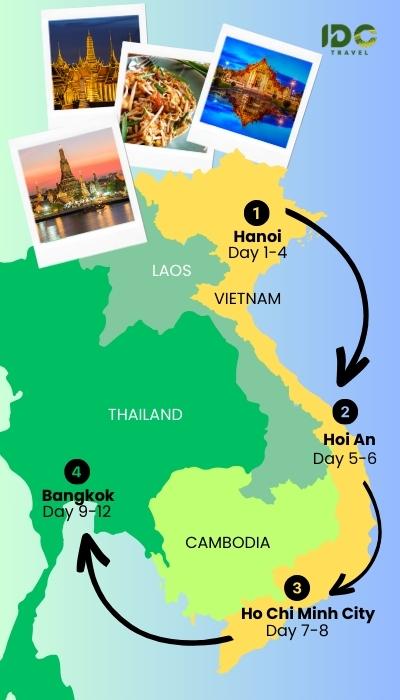
Day 1: Arrive in Hanoi, check-in at the hotel, and have free time to relax.
Day 2: Hanoi city tour, visit main highlights such as Tran Quoc Pagoda, West Lake, Ho Chi Minh Mausoleum Complex, the Temple of Literature, and Vietnam Museum of Ethnology.
Day 3: Transfer to Ha Long Bay and embark on an overnight cruise: visit the Surprising Cave and immerse in the tranquil emerald water by kayaking or swimming.
Day 4: Get up early to enjoy the fresh ocean air and join a Tai Chi session on the sundeck. Continue with a visit to a floating village. End of the cruise itinerary at noon and return to Hanoi. Fly to Da Nang and onward travel to Hoi An.
Day 5: Have the morning explore Hoi An Ancient Town, with beautiful temples and architectural buildings. In the afternoon, take a boat ride along the Thu Bon River to each Cam Kim island, where you can experience the traditional way of life in Vietnam.
Day 6: Morning explores My Son Sanctuary – a World Heritage Site and a religious center of Cham people in Quang Nam province. Return to Hoi An for lunch and then fly to Ho Chi Minh City.
Day 7: Ho Chi Minh City tours over the main tourist destinations like Notre Dame Cathedral, Central Post Office, and Cu Chi Tunnels.
Day 8: Day trip to Mekong Delta, visit My Tho – the capital of Tien Giang province where you can visit a bee farm and join coconut candy making.
Day 9: Fly to Bangkok, Thailand, and have the rest of the day at your leisure.
Day 10: Bangkok city temple tour, visit Wat Traimit, Wat Arun, Wat Pho, and finally the Royal Grand Palace.
Day 11: Visit Damnoen Saduak Floating Market and observe the local way of life. Have free time to go shopping in the afternoon.
Day 12: Depart Bangkok. End of Vietnam and Thailand itinerary.
>>> For the comprehensive tour itinerary, refer to Essential of Vietnam and Thailand in 12 Days Tour.
Itinerary 3: From Ho Chi Minh City
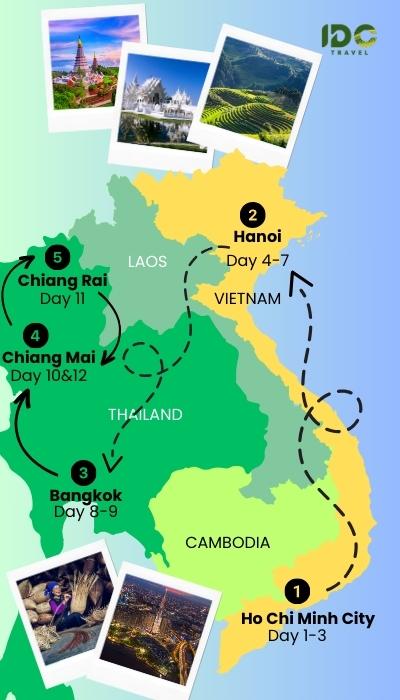
Day 1: Arrive in Ho Chi Minh and enjoy a welcome dinner at a local restaurant.
Day 2: In the morning, you will visit Cu Chi Tunnels – a special network system constructed for living, facility storage, hospital, and even command centers. After lunch, you come back to the city and tour over main highlights such as the War Remnants Museum, Reunification Palace, Notre Dame Cathedral, and Saigon Central Post Office.
Day 3: Explore the Mekong Delta. Have an excursion to Cai Be floating market and An Binh Island, join coconut candy making, and listen to the traditional music of the region.
Day 4: Fly to Hanoi and join a city tour. You will discover Tran Quoc Pagoda and the Temple of Literature. Also, have a cyclo tour around 36 ancient streets at Hanoi Old Quarter.
Day 5: Transfer to Ha Long Bay – the UNESCO World Heritage Site of Vietnam. It is your chance to witness magnificent limestone karsts, swim in the tranquil water, get your luck with night squid fishing, and even join in a cooking class right on the boat.
Day 6: Visit Sung Sot Cave on Ha Long Bay in the morning before returning to Hanoi.
Day 7: Free time to go shopping in Hanoi before flying to Bangkok.
Day 8: Explore Bangkok’s highlights, such as Wat Traimit, Wat Arun, Wat Pho, the Royal Grand Palace, and Wat Phra Kaew. Day 9: Explore Damnoen Saduak Floating Market and Mae Klong Market, two of the most famous shopping paradises in Thailand.
Day 10: Fly to Chiang Mai and tour the city’s beautiful temples, including Wat Phra Singh, and Wat Chedi Luang. Stop at Warorot Market to shop and watch the local way of life.
Day 11: Drive to Chiang Rai, and visit the White Temple, Golden Triangle, and the Long Neck Hill tribe village. Return to Chiang Mai for overnight sleep.
Day 12: Depart Chiang Mai. Complete your trip to Vietnam and Thailand with long-lasting memories.
>>> Check here for the detailed program of this tour. Don’t forget to check our well-planned Vietnam – Thailand tours for different tours of your preference.
Essential Travel Tips
How to Travel Between Vietnam and Thailand
Traveling between Vietnam and Thailand in 12 days is relatively straightforward, primarily due to the frequent flights connecting the major cities of both countries. Key airports include Tan Son Nhat International in Ho Chi Minh City Noi Bai International in Hanoi for Vietnam, and Suvarnabhumi and Don Mueang International Airports in Bangkok for Thailand. Numerous airlines, such as Vietnam Airlines, Thai Airways, and AirAsia, offer direct routes, making flight durations span from just 1 to 3 hours.
While flying is the most popular choice, a land route does exist, though it’s more complex. This entails a journey from Ho Chi Minh City to the Cambodian border, proceeding through Cambodia, and eventually entering Thailand. However, this method requires dealing with multiple transit points and Cambodian visa considerations. Direct sea routes between the two countries aren’t prevalent, but indirect ferry travel via Cambodia is an option, albeit a less common one.
Visa Requirements for 12 Days in Vietnam and Thailand
Vietnam Visa
13 countries are enjoying Vietnam visa exemptions for up to 45 days, including France, Germany, Italy, the UK, Spain, Russia, the Republic of Korea, Japan, Denmark, Norway, Sweden, Belarus, and Finland. So, if you are from one of these countries and plan to spend 12 days in Vietnam and Thailand, you don’t need to apply for a Vietnam visa.
If you are not eligible for the visa exemption policy, you can apply for a Vietnam E-visa, which is valid for a 90-day stay duration and multiple entries. The steps are very simple, just check out our article here.
Thailand Visa
According to Thailand’s visa policy, citizens from over 50 nations can enter Thailand for tourism without a visa, including, Australia, France, Germany, Japan, the US, the UK, Singapore, etc. They need to show a passport that’s valid for a minimum of six months. Depending on their nationality, their stay can range from 14 to 90 days.
There’s an option for an electronic travel document, collectible at specified Thai entry ports for travelers, including Don Mueang (DMK), Suvarnabhumi (BKK), Phuket (HKT), and Chiang Mai (CNX). Countries eligible for Thailand E-Visa are China, Mexico, India, Taiwan, Uzbekistan, etc. This eliminates the need to apply at an embassy and attend an in-person interview. If you are from one of these nations, you can also opt for a visa upon arrival. However, they would need to undergo the visa procedures at any of the country’s 48 immigration checkpoints.
Travelers from the rest 150 other nations must secure a traditional visa from their nearest consulate or embassy.
Now, we hope that you know the best places to visit as well as how to plan your 12 days in Vietnam and Thailand. The new updated visa policies of both countries are favorable to travelers, the transportation is also very convenient. Your only responsibility is to choose the most suitable time and a suitable itinerary. Still, find it hard to decide, contact us right here for a private consultation.
Read more:

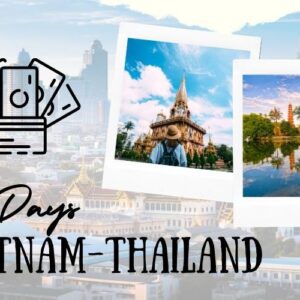
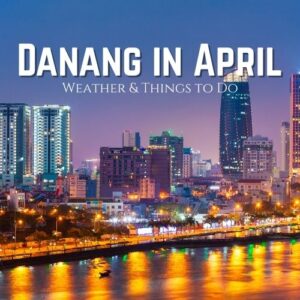
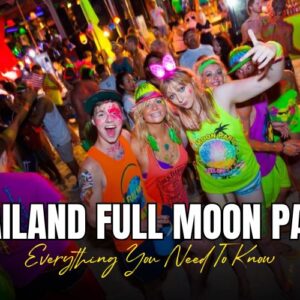
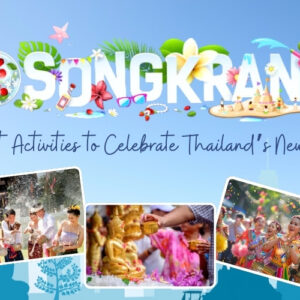
I have looked at the itinerary carefully and still feel that it is quite rush. Both Vietnam and Thailand have many things to enjoy and discover. May I combine Vietnam with Laos or Cambodia? I think it will be a better choice.
Hi Storm,
Of course, you can combine Vietnam and Laos or Vietnam and Cambodia for your trip to Southeast Asia if you want. Please check out well-planned tours for detailed itineraries.
Don’t hesitate to contact us if you need help to plan a customized tour program.
Thank you so much!
Best regards,
Alice Pham.